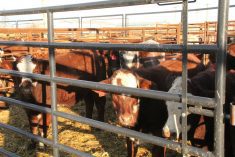The latest release from the George Morris Centre “Feed grains and livestock in Canada – a reconciliation” brings to mind the lyrics from a certain operetta performed by the Carman Collegiate High School back in the 1970s.
“Oh, the farmer and the cowman should be friends… one man likes to push a plow, the other likes to chase a cow, but that’s no reason why they can’t be friends.”
It was an east wind combined with the theme song from that operetta, “Oklahoma,” that made the performance so memorable. Just as the leading male pushed his cracking teenage voice into the lyrics “where the waving wheat can sure smell sweet,” the school’s air circulation system coincidentally filled the theatre with the stench from a cattle feedlot southeast of town. The audience roared, much to the consternation of the cast on stage.
Read Also

Manitoba canola industry has new frontiers
Canola oil is still the main priority for the sector, but canola meal is increasingly the subject of research looking for new markets and uses for the oilseed’s byproduct.
George Morris Centre authors Al Mussell, Graeme Hedley and Doug Hedley, might face a similar reaction to their observation that Canada can’t have a healthy livestock sector without a healthy grain sector and vice versa.
The grain and livestock sectors are interconnected, the report says, and if treated as independent from a policy perspective, or one given precedence over the other, both will suffer. It’s not the relative price that matters, it’s the basis.
This, from a policy think-tank that has fuelled the effort to diminish Canada’s quality control system for export grains in the name of ensuring the livestock sector has greater access to cheap feed?
As recently as 2007, Mussell blamed Canada’s “archaic” grain regulatory system, the Canadian Wheat Board’s single desk for barley exports and the varietal registration system for discouraging the development of high-yielding feed barley varieties.
At that time, he told his audience that ending the board’s single desk would result in more growers producing feed barley and more research into feed barley varieties. But when asked to explain how, he didn’t have an answer.
In reality, the likelihood is that barley research would decline in the absence of the board’s single desk. Much of the barley research that takes place in Canada is by public researchers who tap into the Western Grains Research Foundation checkoff on sales to the Canadian Wheat Board. No research checkoff is currently applied to domestic feed barley sales.
Mussell’s observations at the Manitoba Swine Seminar were based on the assumption that farmers would prefer to grow low-value, high-volume feed barley for livestock than to play the “maybe malt” game and turn to the livestock market for salvage if they fail to achieve malting quality.
The question is, why? Canadian feed grains are priced against U. S. corn, which up until recently, was plentiful and cheap thanks to U. S. farm support programs – so cheap that Canadian producers couldn’t make money growing them.
Feed grain production in Canada has historically been an accident of nature. It has always made sense for Canadian grain producers to aim for export or food quality with their production, unless of course they are feeding their own livestock.
The paper is another attempt to convince governments to see the short-sightedness of policies promoting grain-based ethanol. “Because it is dependent upon compulsion (blend mandates) and production subsidies, making ethanol from feed grains by definition does not add value,” the authors said. “Moreover, it stands to make livestock and meat industries that do add value to feed grains uncompetitive.”
On this front however, the George Morris paper makes a valid point.
It asks, “Do Canadian feed grain producers care whether their customers are local livestock feeders or ethanol plants? In the immediate term perhaps not, but by championing development of a policy-driven industry at the expense of a market-driven one, the risks and pitfalls of this strategy within the feed grain segment must be recognized.”
Because livestock flow to the feed, and because feed grain prices will be pushed higher due to ethanol demand during the short term, the study’s authors predict livestock-on-feed will decline, which will be followed by fewer investments in slaughter capacity.
Meanwhile, further developments in biofuels could see the sector transition rapidly to non-food or non-feed ingredients, leaving grain producers with not one, but two diminished markets.
The study’s authors recommend feed grain producers back away from their support of grain-based ethanol. It calls on the livestock and meat segments to “rally behind the feed grain segment as key partners, and to work together on a holistic and far-reaching strategy to add value to Canadian grains by conversion to meat.”
It’s fine to say livestock adds value to grain. But unless the grain farmer has a stake in the value-added industry, feed grains are just another marketing alternative. And the more the merrier.
Farmers and cowmen should be friends. Can they be business partners too?



















